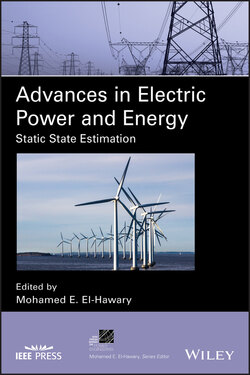Читать книгу Advances in Electric Power and Energy - Группа авторов - Страница 18
1.4 STATIC STATE ESTIMATION IN PRACTICE
ОглавлениеThe material in this section is based on a NERC Task Force report [7]. To quote the Task Force:
This report presents the findings and recommendations of the North American Electric Reliability Corporation (NERC) Real‐Time Tools Best Practices Task Force (RTBPTF) concerning minimum acceptable capabilities and best practices for real‐time tools necessary to ensure reliable electric system operation and reliability coordination. RTBPTF's undertaking is based on the U.S.‐Canada Power System Outage Task Force findings that key causes of the August 14, 2003 northeast blackout included absence of situational awareness and inadequate reliability tools. That report also notes the need for visualization display systems to monitor system reliability.
RTBPTF's recommendations result from an extensive, three‐year process of fact‐finding and analysis supported by the results of the Real‐Time Tools Survey, the most comprehensive survey ever conducted of current electric industry practices.
RTBPTF's findings and recommendations are firmly grounded in the results of the Real‐Time Tools Survey, a more than 300‐page, web‐based document with nearly 2,000 questions on a broad scope of current industry practices and plans for using real‐time tools.
While [21] referred to RTUs as the eyes and ears and hands of the master station, the phrase came to be commonly used to refer to the state estimator as the eyes and ears of the real‐time operator. Indeed, in current practice the state estimator prevails as an “essential” tool for power system operators' “situational awareness.” Existing NERC reliability standards assume the use of state estimators to aid RCs and TOPs in maintaining situational awareness for the bulk electric system. The state estimator must be available and able to produce an accurate solution because many applications rely on the state estimator solution as base case.
State estimators are commercially available allowing SCADA/EMS vendors to provide viable state estimators off the shelf with some customization and fully integrated with users' production SCADA/EMS systems. State estimators are used as input to monitor MVA/ampere loadings and low and high bus voltages, voltage drop, voltage node angle separation, SCADA, and visualization. Therefore, it is important that it be available and produce an accurate solution.
Single‐pass methods execute one estimation that simultaneously includes internal and external networks, observable/internal network, and nonobservable/external network solved together. The two‐pass method deals with two state estimates, one for the internal system and another for the external system or for the entire system (observable/internal network and nonobservable/external network solved separately). Many in the power industry prefer using a single‐pass over a two‐pass solution.
According to [22], the single‐pass method suffers from numerical instability. An enhancement to the one‐pass method uses a set of critical external pseudo‐measurements. Some alternative two‐pass state estimators require a load flow study for the external system. Both two‐pass methods reduce the effects of boundary errors in the internal system solution by properly weighing the external pseudo‐measurements, but they may result in very high or negative loads and generations in the external system. Zero‐injection buses are more commonly treated as high‐confidence bus injection measurements than as hard constraints.
For an overwhelming majority of users, the state estimator solution is used as a base case for reliability‐analysis applications such as contingency analysis (CA), power flow (PF), and as input to system analysis tools such as:
1 Online/operator PF
2 Offline PF
3 Locational marginal pricing (LMP)
4 Voltage stability analysis
5 Security‐constrained economic dispatch
In some cases, the state estimator is used primarily as the basis for information communicated to operators regarding power system status; e.g. the state estimator drives the alarm application that alerts operators to impending power system events.
